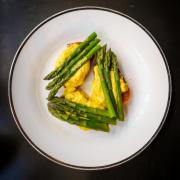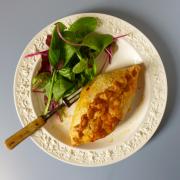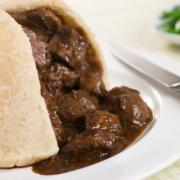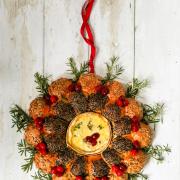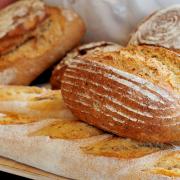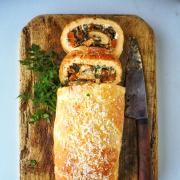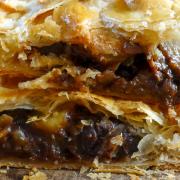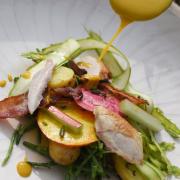You don’t need to be afraid of cooking seafood, says Charlotte Smith-Jarvis
Does the mere mention of cooking fish make you break out in a cold sweat? You’re not alone. Of all the ingredients that strike fear into the hearts of home cooks, seafood must be perched (excuse the pun) right at the top.
Anything from the ocean seems to have taken on a notoriety for being difficult to prepare when, in fact, fish and shellfish are some of the quickest, easiest - and healthiest – partners you can have in the kitchen.
I think a lot of our unease and lack of confidence around fish comes down to the rise of convenience food over the last five decades. Friday’s fish suppers, once so ubiquitous across the UK, have been eschewed in favour of the Friday night takeaway.
And the high street fishmonger has largely been relegated to history, meaning the quickest access most of us have to the sea’s treasures is via a supermarket – where the ‘catch of the day’ could easily prove to be several weeks old.
I want to inspire you to seek out your closest fishmonger (for most of us at our local market) and have a go at one of my uncomplicated recipes. I’ll show you how to cook a fillet, flat fish and smoked fish, in dishes that can be easily adapted and built upon.
Your fishmonger will be delighted to talk to you about what’s in season (because, yes, fish is seasonal), and to prepare most things to the point of being oven or pan ready – from scaling and skinning, to filleting and deboning. Use them. Use their skills. They’re only too happy to help.
I sourced my key ingredients from Crystal Waters, whose van visits my home town of Hadleigh every week. The family business can be found at markets in Southwold, Halesworth and Newmarket too.
It’s always service with a smile, and the guys on the vans are super knowledgeable, with wares ranging from spanking fresh crab, bass, cod, bream and tuna, to their own rich, deeply flavoured hot smoked salmon and mackerel. The smoked fish in particular always draws me in. Salmon is smoked in thick tranches, ensuring every bite retains its succulence.
The team smokes this, and other fish, in its dedicated sheds in Lowestoft, where they also have a digital German kiln, enabling them to produce old fashioned favourites such as buckling (hot smoked herring).
You can find them in Halesworth on Wednesdays from 7.30am to 2.30pm, Southwold on Thursdays (8am to 3pm), Hadleigh on Fridays (8am to 2pm) and Newmarket Fridays and Saturdays (7.30am to 2.30pm).
If you’re by the coast, you can pick up fresh fish from the sheds at Old Felixstowe, Lowestoft, Southwold Harbour and along Aldeburgh beach. The newly revamped Friday Street Farm Shop, just off the A12, has a fishmonger, as does Aldeburgh Market on the town’s high street. And don’t forget the Fish Box in Woodbridge, or Pinneys at Orford.
Ultimate salmon fish cakes
(Makes 6)

Hot smoked salmon at its best is luscious and has an almost, I think, seductive flavour that begs you to take another bite. Brought to room temperature alongside a plate of lightly dressed green salad and buttered new potatoes, it’s a fine, easy lunch or dinner. If you want to take it one step further, fishcakes are the way to go. Leave out the melting cheese sauce filling if you want to save time, but this too has been simplified, and imparts a gooey, sharp contrasts against the flakes of fish. These are great to have in the freezer. Once browned on the outside and cooled (before oven baking), open freeze on a tray, and seal in tubs or bags until you want to eat. Cook them at 190C from frozen for 30 minutes.
Ingredients
500g hot smoked salmon, skinned, any bones removed, and flaked
500g potato, baked in skins until tender then mashed
Seasoning
Cheese, chive and cider filling:
150g strong cheese, grated
100ml cider
1tbsp cornflour
½ clove garlic, crushed
2tbsps fresh chives, chopped
1 egg yolk
1/2tsp English mustard
Splash Worcestershire sauce
To coat:
2 eggs, beaten
300g white breadcrumbs
Oil for cooking
Method
Put all the ingredients for the sauce in a small pan on a low heat, just under a simmer, until the cheese has melted. Bring the heat up to a simmer and stir constantly until it’s thickened and will coat a spoon – like custard.
Decant into a shallow dish and pop in the fridge to set.
Combine the flaked fish with the mashed potato and season. Chill for one hour. Divide the mix into six large balls (larger than a Scotch egg). Take one of the balls and press it down on a piece of greaseproof paper to about 1.5cm thick. Scoop a tablespoon of the cheese filling into a rough ball and place at the centre of the flattened potato mix. Bring the potato/fish mix up around the cheese filling to seal. Repeat with the remaining fishcakes.
Now dip your fishcakes in the beaten eggs and carefully roll in the breadcrumbs. Pop in the fridge until needed (up to two days).
To cook, pour about half a centimetre of oil in a frying pan. Bring to a medium/high heat and pop in a couple of fishcakes (don’t attempt to do lots at one time). Cook gently on each side, until the crumb coating is golden. Transfer to kitchen paper to drain while you cook the rest of the cakes. To finish, place on a lined baking tray and bake in the oven at 200C for 15 to 20 minutes.
Warm up any leftover sauce to serve on the side. Lovely with a crisp green salad and a glass of English fizz, Chardonnay, Chenin Blanc or Sauvignon Blanc.
Sea Bream in an aromatic broth with summer greens
(Serves 2-4)

Sea bream is an excellent, delicate white fish that’s quite forgiving for home cooks. It has a touch of seashore salinity that stands up beautifully to Asian spicing. Here, it’s pan-cooked and served in a broth with lightly cooked greens and pops of sharp pickled courgette.
The technique I use for pan frying was given to me by Michelin-starred chef Galton Blackiston, who uses the method at home and in his professional kitchen. Lightly ‘curing’ the fish before cooking helps it to stay firm, retaining its shape, while the trick of using scrunched up baking parchment in the pan, means less fear when it comes to turning. You can do this with any fish fillet. The skin will still crisp up, and the water in the paper helps to steam the flesh.
The broth is a base which you can add to as you see fit. A few lime leaves, lemongrass and a splash of coconut milk will give a creamy finish. Ramp up the chillies if you like it hot. It’s up to you.
Ingredients
1 fillet of sea bream per person, descaled and deboned
Salt
Oil
For the broth:
1lt fish or chicken stock
2 star anise
1 small piece of ginger, sliced
4 cloves of garlic, sliced
Large pinch chilli flakes
2tsps fish sauce
1 bunch spring onions, finely chopped
For the courgette:
1 medium courgette, diced finely
Salt
1 lemon
Olive oil
To serve:
1 handful shredded greens per person
Method
Put all the broth ingredients in a large saucepan. Bring to the boil, then simmer for 30 minutes. This can be done up to four days in advance. Just before eating, bring back to the boil and keep at a simmer until the fish is ready.
To prepare the courgettes, toss in a small bowl with a large pinch of salt, squeeze of lemon and drizzle of oil. Set aside.
Five minutes before cooking, sprinkle the flesh of the fish with sea salt. Once five minutes is up, rinse the fish in fresh cold water and pat completely dry. Brush with oil all over.
Now, take a piece of baking paper, just large enough to fit under the fish with 3cms space on each side. Wet it under a running tap and scrunch. Place a couple of pieces of prepared parchment in a frying pan and pop a fish fillet, skin side down, on each. Cook for three minutes on a medium to high heat, gently pushing down to ensure maximum contact with the pan. Then turn over carefully and cook for a further two to three minutes. When you turn over the fish, add the greens to your pan of broth and bring to the boil to wilt.
Ladle the broth into shallow dishes, place the fish on top, and finish with crisp pops of courgette.
Sole with sumac, garlic and orange butter and chunky ‘roast potato’ chips
(Serves 2)

Baking whole fish can seem daunting, but it’s actually one of the easiest things in the world. Season, pop in a pan, stick it in the oven, and in under 20 minutes dinner’s ready. Get your fishmonger to do any gutting and scaling for you.
You'll have leftover butter from this recipe, which will keep in the fridge for a couple of days, or can be frozen in portions. It’s delicious smothered over hot, crusty baguette – a kind of fancy garlic bread - and will work with pork, chicken or any other white fish.
The double cooked chips are the creation of Suffolk chef James Barber (currently at The Red Lion in East Bergholt). Next time you’re making baked potatoes, throw a few extra in the oven to make these the next day.
Ingredients
1 large Dover or Lemon sole, descaled and oven ready – about 400-500g. Seasoned.
For the butter:
150g unsalted butter, at room temperature
2 cloves garlic, crushed
1tsp sumac
Zest of 1 orange
1/2tsp fine sea salt
For the chips:
1 large potato per person, scrubbed and baked in the oven until tender, cooled
Oil to cook
Method
Combine all the butter ingredients and roll in greaseproof paper. Pop in the fridge for at least an hour to set.
Pre-heat the oven to 220C.
Remove the skins from the potatoes and cut into chunky chips or wedges. Brush with oil and place on a baking tray.
Put the chips in the oven. After 10 minutes, turn them over. Now place the fish in an ovenproof dish, brush lightly with oil and sprinkle with a little salt.
Pop this in the oven too, and set the timer for 15 minutes.
Remove the fish from the oven and slice some of the prepared butter over the top. Then remove the chips.
Serve together, making sure everyone gets a scoop of the buttery juices from the pan. A simple salad on the side is all that’s needed.



